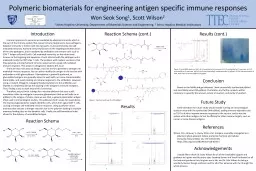

Won Seok Song 1 Scott Wilson 2 1 Johns Hopkins University Department of Materials Science and Engineering 2 Johns Hopkins Medical Institutions Introduction Reaction Schema Conclusion ID: 930027
Download Presentation The PPT/PDF document "Polymeric biomaterials for engineering a..." is the property of its rightful owner. Permission is granted to download and print the materials on this web site for personal, non-commercial use only, and to display it on your personal computer provided you do not modify the materials and that you retain all copyright notices contained in the materials. By downloading content from our website, you accept the terms of this agreement.
Slide1
Polymeric biomaterials for engineering antigen specific immune responses
Won Seok Song
1
, Scott Wilson
2
1
Johns Hopkins University, Department of Materials Science and Engineering,
2
Johns Hopkins Medical Institutions
Introduction
Reaction Schema
Conclusion
References
Acknowledgements
Based on the NMRs and gel obtained, I have successfully synthesized p(Man) and most likely some OVA-p(Man). Purification and further analysis will be necessary to quantify the amount, extent of reaction, and purity of product.
+
Figure 2. (a-e) NMR spectra of (a) 1-(2-chloroethyl)-
α-
D-mannose, (b) 1-(2-azidoethyl)-
α-
D-mannose, (c) 1-(2-aminoethyl)-
α-
D-mannose, (d) N-[2-(
α-
D-mannose)ethyl]
methacylamide
, (e) p(Man). (f) Gel electrophoresis of OVA, OVA-linker, and OVA-p(Man) conjugate.
Figure 1. Synthesis pathway for OVA-p(Man).
Results
Results (cont.)
Reaction Schema (cont.)
Immune responses to vaccines are mediated by adaptive immunity, which is the part of the immune system that causes immune responses to new pathogens. Adaptive immunity is further split into two parts, humoral immunity and cell-mediated immunity. Humoral immunity focuses on the targeting and destruction of the new pathogens, and is mediated by antibodies and immune cells such as CD4
+
T helper cells and B cells. Cell-mediated immunity, on the other hand, focuses on the targeting and apoptosis of cells infected with the pathogen and is mediated mostly by CD8
+
killer T cells. The problem with modern vaccines is that they generate a strong humoral immune response but a weak cell-mediated immune response. This project is designed to address this issue.
There are two main ways to design a vaccine to try to generate a stronger cell-mediated immune response. You can either modify the antigen in the vaccine with antibodies or with glycosylations. Glycosylation is generally preferred, as glycosylated antigens are generally easier to work with, are more characterizable, more stable, and avoid creating an immune response to the antibodies. However, using a covalent linkage to conjugate the glycosylations to the antibodies can impede or completely disrupt the docking of the antigen to immune receptors. Thus, finding a way to work around this is essential.
Therefore, we put forth a design for a vaccine platform that uses a self-immolative linker to conjugate a mannose glycopolymer that we will refer to as p(Man) to the antigen of choice. Here we use OVA, a general placeholder antigen often used in immunological studies. This addresses both issues discussed above. The mannose glycopolymer targets dendritic cells, which then signal CD8
+
T cells, causing a stronger cell-mediated immune response. Using a polymer of the mannose also ensures a stronger reaction due to the polymer docking to multiple mannose binding sites on the dendritic cells. Finally, the self-immolative linker allows for the delivery of unmodified antigen.
Wilson, D.S.,
Hirosue
, S.,
Raczy
, M.M. et al. Antigens reversibly conjugated to a polymeric
glyco
-adjuvant induce protective humoral and cellular immunity. Nature Mater 18, 175–185 (2019). https://doi.org/10.1038/s41563-018-0256-5
I would like to thank Dr. Scott Wilson for all of the invaluable support and guidance he’s given me this entire year, Sandeep Kumar and Vivek Hariharan for all the help and guidance they’ve given me in lab, and Dr. Orla Wilson for being a wonderful Senior Design professor and for all of her patience with me through this whole process.
a
b
c
d
e
f
Future Study
Some directions for future study would include running an immunological study on mice with the synthesized OVA-p(Man), adding immune adjuvants such as TLR7 to further improve immune response to the vaccine, and to test the system with other antigens to test its efficacy for other immune targets, such as cancer or Lyme disease antigens.